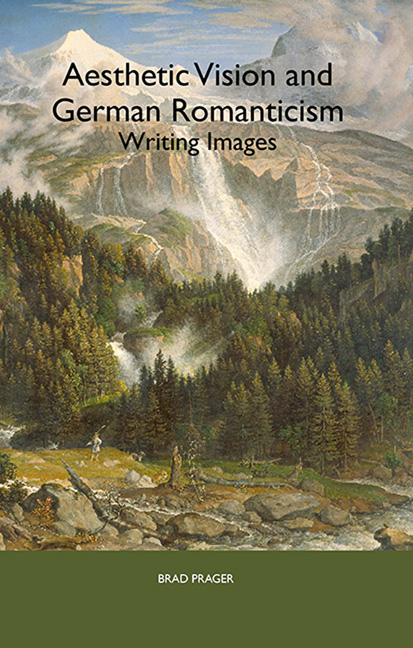Book contents
- Frontmatter
- Contents
- List of Illustrations
- Acknowledgments
- Introduction
- 1 Interior and Exterior: G. E. Lessing's Laocoon as a Prelude to Romanticism
- 2 Image and Phantasm: Wackenroder's Herzensergießungen eines kunstliebenden Klosterbruders, Tieck's Franz Sternbalds Wanderungen, and the Emergence of the Romantic Paradigm
- 3 Symbol and Allegory: Clemens Brentano's Godwi
- 4 Sublimity and Beauty: Caspar David Friedrich and Joseph Anton Koch
- 5 Light and Dark: The Paintings of Philipp Otto Runge
- 6 Absolution and Contradiction: Confrontations with Art in Heinrich von Kleist's “Die heilige Cäcilie oder Die Gewalt der Musik” and “Der Findling”
- 7 Self and Other: Joseph von Eichendorff's Das Marmorbild
- Conclusion
- Notes
- Works Cited
- Index
3 - Symbol and Allegory: Clemens Brentano's Godwi
Published online by Cambridge University Press: 13 April 2017
- Frontmatter
- Contents
- List of Illustrations
- Acknowledgments
- Introduction
- 1 Interior and Exterior: G. E. Lessing's Laocoon as a Prelude to Romanticism
- 2 Image and Phantasm: Wackenroder's Herzensergießungen eines kunstliebenden Klosterbruders, Tieck's Franz Sternbalds Wanderungen, and the Emergence of the Romantic Paradigm
- 3 Symbol and Allegory: Clemens Brentano's Godwi
- 4 Sublimity and Beauty: Caspar David Friedrich and Joseph Anton Koch
- 5 Light and Dark: The Paintings of Philipp Otto Runge
- 6 Absolution and Contradiction: Confrontations with Art in Heinrich von Kleist's “Die heilige Cäcilie oder Die Gewalt der Musik” and “Der Findling”
- 7 Self and Other: Joseph von Eichendorff's Das Marmorbild
- Conclusion
- Notes
- Works Cited
- Index
Summary
Although he wrote his novelGodwi, oder Das steinerne Bild der Mutter (hereafter Godwi) in Jena, Clemens Brentano was not really part of the Jena circle of Romantics. His real fame as a Romantic writer and poet came after he moved to Heidelberg and became associated with a circle of writers that included Achim von Arnim, Josef Görres, and Friedrich Creuzer, among others. Together with von Arnim, Brentano published an anthology of Volkslieder (folk songs) called Des Knaben Wunderhorn: Alte deutsche Lieder (The Youth's Magic Horn) in three volumes between 1805 and 1808. As a result, they became the leading figures of the Romantic movement during the first decades of the nineteenth century. With them, the center of Romanticism shifted away from Jena to Heidelberg.
Here, however, I am primarily concerned with the period immediately preceding that shift, the years around 1800, during which Brentano wrote the novel Godwi, a lengthy fictional meditation on love and art that was less well received than his later efforts. He wrote it in Jena in 1798–99 and it was published in 1801. It expresses opinions on a number of themes that were current around that time. Even though he was not a full-fledged member of their group, he was on good terms with the Jena Romantics, and the work is in some measure consistent with their philosophical approach. One could even argue that it adheres wholesale to their project. It is formally linked to the Schlegels’ writings insofar as it presents a rich mixture of poetry, prose, dialogue, and other forms that Friedrich Schlegel once said defined the novel as the archetype of the “romantic book,” which subsumed all the other forms within it. Godwi also demonstrated important theoretical continuity with their thought. As I will argue, Brentano may have even pushed their positions further than they themselves had intended, moving away from classicism and idealism and creating a work that was paradigmatic for the infinite deferral of meaning that ultimately came to be associated with Romanticism. After providing some background on this thoroughly Romantic work, I explore the deferral of meaning made manifest in the signifying systems of Godwi in order to shed light on how the Romantic subject defines itself against the phenomenal world. The encounters with art in the novel illustrate the way we represent the world in the imagination.
- Type
- Chapter
- Information
- Aesthetic Vision and German RomanticismWriting Images, pp. 66 - 92Publisher: Boydell & BrewerPrint publication year: 2007



